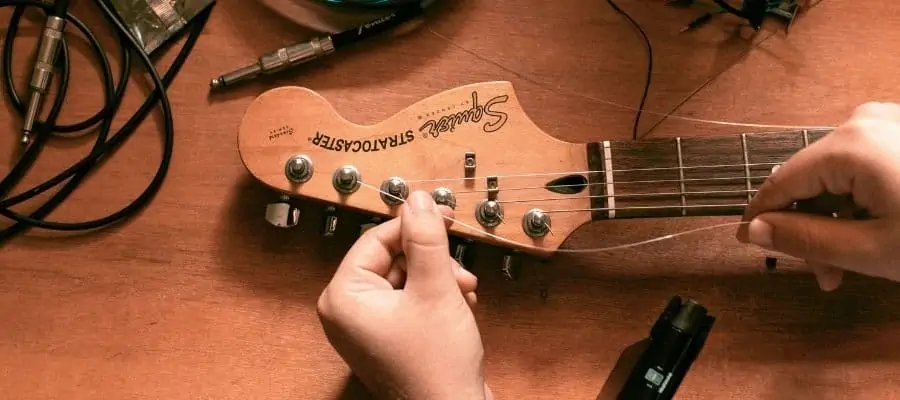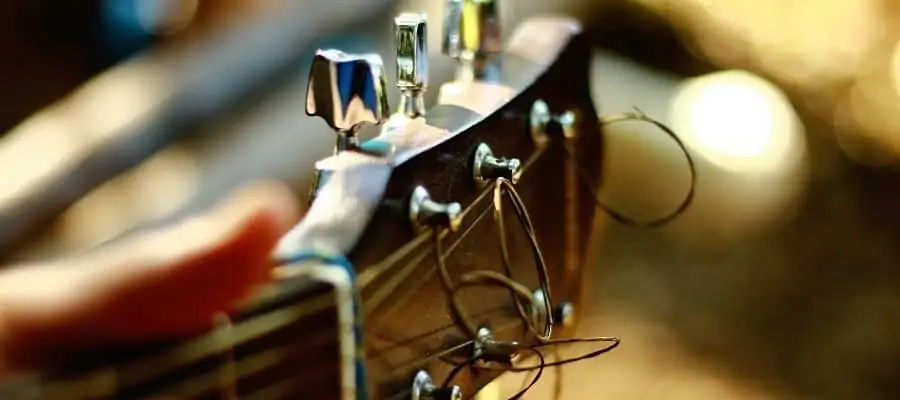Buying a new guitar is an exciting time. But you also have a few challenges that you need to overcome when you buy. Can you just start playing or you should make some adjustments and replace something? One of these changes involves the strings that ship with your new guitar.
So should I change the strings on my guitar? The short answer is Yes. You should be changing the strings on your guitar in most instances. Because the guitar strings have been on for a long time before you bought the guitar. However, sometimes the shop will do it for you without extra costs.
The strings on your new guitar may or may not be ideal when you buy the guitar. Several factors determine whether strings need changing. Keep on reading to find out what they are
Reasons Why You Should Change Your Strings

There are several reasons why you should change your guitar strings. Most new guitars should have strings replaced to improve the sound of your instrument. Here are some reasons why you should replace them.
The Strings Have Been On A Long Time
A guitar leaves the factory with a set of fresh strings. All new guitars get fresh strings before boxing. The problem is that the guitar could sit in a factory box for months or even years before it’s sold. Once a music store buys the guitar it might sit on the wall of the shop for a long time. Most stores won’t apply fresh strings to the new guitars they buy as this costs too much money. When you buy a new guitar, the strings are rarely fresh.
You Want To Protect Your Fretboard
Old strings are usually corroded or have a lot of dirt on them. These instruments are in boxes in the back of a guitar store. The guitars will it in those boxes for months. in many instances, so you’re not going to get a guitar with the freshest strings on it. You don’t want this old grime to get onto the guitar fretboard as the board could suffer damage. If you buy an expensive guitar you’ll want to keep it in good condition. Remove the old corroded strings and out on a fresh set.
Make The Guitar Sound Better
You won’t get the sound that you want with old strings. When strings get old they are harder to play as you can’t slide up and down old strings that well. This means your playing only sounds as good as you’ll fight the strings more often than not. You don’t want to struggle to get a good tone out of them. Old strings are harder to keep in tune and may go out of tune often when you play for a long time.
When Strings Don’t Need Changing

The Guitar Shop Already Changed Them
The guitar store where you bought the guitar may have already put on a new set of strings for you. Some stores will do this when you buy them. If the strings don’t appear to look corroded and are shiny, they won’t need changing when you take the guitar home. You need to examine the strings and make a decision.
They Sound Good And Look Clean
Sometimes you can stumble upon a guitar with a set of strings in a good condition If the strings sound good to your ears or look clean and unused. You can leave them on for a while longer and save yourself some money. Don’t change the strings if you feel they don’t require it.
How To Pick The Right Guitar Strings For You

There are different types of guitar strings as well as string sizes that you need to know about. Your guitar will sound its best with the right type of string. This will also depend upon your individual preferences. Pick the strings that work the best for your needs.
Acoustic Strings Vs. Electric Guitar Strings
Make sure you use the right set of strings for your guitar. Never put acoustic strings on an electric guitar or electric strings on an acoustic as this can damage the guitar. Acoustic strings tend to use bronze or brass strings while electric strings tend to be nickel. Classical guitars use nylon strings. Make sure you get the appropriate string type for your guitar.
Picking The Right String Metal
Use this short guide to determine the best electric or acoustic guitar strings to meet your needs. In most cases, nickel is the best for electric and phosphor bronze for acoustic.
Electric Guitar
- Pure Nickel – These have a warm tone and aren’t as bright as nickel-plated strings
- Nickel-plated – They have good attack, warmth, and brightness
- Stainless steel – These have a crisp and bright tone, with some corrosion resistance
- Chrome – These don’t resonate as well but have warmth.
- Titanium – These are bright and have added strength
- Cobalt – These have brightness and a dynamic response
Acoustic Guitar
- Bronze – These have a bright, clear and ringing tone. They don’t last as long as others as bronze oxidizes
- Aluminum bronze – These have a crisp sound and good bass when compared to phosphor bronze
- Phosphor bronze – These are darker and warmer than regular bronze. The phosphor gives the strings more life
- Brass – these have a metallic and bright tone
- Silk and steel – These have a core made with nylon, silk, or copper wire. They have a delicate and warm tone. Fingerstyle and folk players often use these
- Nylon – Used on classical guitars
Get The Right Guitar Gauge
The gauge of your strings matters. In general, a 09, or a 10 is the ideal choice. The 09s are best for beginners as they are easier to play. On acoustic, the extra light strings are a 10 gauge and these are the best choice for beginners. You’ll need to experiment a bit with your strings to find a gauge that works best for you. Lighter strings are easy to play. Heavier strings need more finger strength.
These are the typical gauges. There are a few others that are not listed here.
Acoustic String Gauge Thickness
- Extra light: .010 .014 .023 .030 .039 .047
- Custom light: .011 .015 .023 .032 .042 .052
- Light: .012 .016 .025 .032 .042 .054
- Medium: .013 .017 .026 .035 .045 .056
- Heavy: .014 .018 .027 .039 .049 .059
Electric Guitar Gauge Thickness
- Extra Super Light: .08 .010 .015 .021 .030 .038
- Super Light: .009 .011 .016 .024 .032 .042
- Light: .010 .013 .017 .026 .036 .046
- Medium: .011 .015 .018 .026 .036 .050
- Heavy: .012 .016 .020 .032 .042 .054
Coated vs. Non-Coated
There are different types of strings and some have a coating on them. These coated strings are ideal as they take a lot longer to oxidize. The coating is smooth and allows your finger to glide over the stings. Your strings will last around 3-4 months or more with coated strings. Non-coated strings last around 2 weeks or so. Coated strings are an individual preference. One main advantage is that they don’t get dirty. You’ll have far less grime and dirt on your fretboard when you use coated strings. Be sure to wash your hands before you play for an even longer life. You will have to try them on your own. Some players find them too slippery and prefer regular strings that aren’t coated.
I personally use Elixir strings, which are coated strings. If you are interested to know whatever they worth the money check out my post Do Elixir Strings Really Last Longer? Are They Worth It?
What Else You Can Do To Make Sure Your Guitar Has The Right Setup

Your guitar will sound its best when it has the right setup. Several factors go into a good guitar setup. You can do some changes before you apply the strings and some after you have new strings on.
Before String Change
- Check Tuning Pegs
Make sure the tuning pegs are secure and that the screws are tight. A loose tuning peg makes it harder to keep the guitar in tune and the string may not tune at all. If you have a poor tuning peg, replace it with a new one. - Look for Loose Bridge Pieces
On an electric guitar, you may have a loose piece on the bridge. This might be a spring or another part, On an acoustic guitar, this might be a bridge pin. Loose pieces need to be replaced as these interfere with the tuning. Tighten other parts of the guitar that appear to be loose.
After Changing Strings
- Truss Rod
The truss rod may need a minor change. If you don’t know how to do this, see a guitar technician. If the truss rod is out of alignment the strings may buzz against the fretboard. - Check String Action
You may want to change the string action to meet your needs. You can do this via the bridge on an electric guitar. On an acoustic guitar, this is difficult and a qualified professional should do this. String action is a personal preference. You will need to experiment with the action until you find the action that you like. - Tune Slowly
The new string needs stretching. Slowly tune each string and tug at the string or to help stretch it out. Never over tune the guitar as the string can break. They are sensitive to breaking when new as they need stretching first. Tune the guitar, play a bit and then re-tune a few times to get the string into a stable tuning. - Cut Off Excess String
Make sure you cut off the excess string by the tuning pegs. This helps stabilize the tuning. Cut the string short by the machine head post. - Intonate
The guitar needs intonation. You don’t need to do this after each string change but it needs intonation a few times each year. A guitar technician can do this for you or you can do it yourself if you know the steps. Intonation keeps the tuning stable throughout the entire guitar neck.
Conclusion
In most cases, you should change your strings when you buy a new guitar and I recommend it. Unless the strings look like they are new. A new set of strings on your new guitar gives you the best sound.
If you found this article useful, you may want to save this pin below to your Guitar board.

Recent Posts
When learning new songs have you noticed that some of the chord sequences sound really good? But when you tried to come up with your own chord sequence, or as we call it chord progression, you found...
Some guitarists insist on buying an expensive amplifier with their electric guitar. They assume that this is a must for every type of guitarist out there. However, in some situations, this isn’t...

